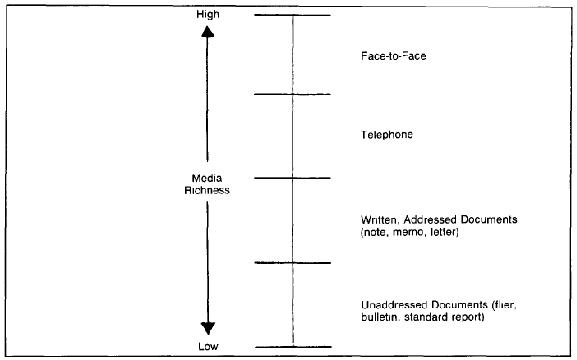Media richness theory

Media richness theory
Acronym
N/A
Alternate name(s)
N/A
Main dependent construct(s)/factor(s)
Information processing, communication effectiveness
Main independent construct(s)/factor(s)
Uncertainty, equivocality
Concise description of theory
The first assumption of this theory is that organizations process information to reduce uncertainty and equivocality (Daft and Lengel 1986). Uncertainty is defined by Galbraith (1977) as “the difference between the amount of information required to perform the task and the amount of information already possessed by the organization.” Equivocality is defined as the ambiguity of the task, caused by conflicting interpretations about a group situation or environment. Therefore, when equivocality is high, an individual does not know what questions to ask and when uncertainty is high the group knows the question but lacks the necessary information. In conclusion, as information increases, uncertainty and equivocality decrease.
The second assumption of this theory is commonly used media in organizations works better for certain tasks than others. Specifically, Daft and Lengel (1984) concluded that written media was preferred for unequivocal messages while face-to-face media was preferred for messages containing equivocality.
Daft, Lengel, and Trevino (1987) present a media richness hierarchy which incorporates four media classifications; face-to-face, telephone, addressed documents, and unaddressed documents. The richness of each media is based on four criteria; feedback, multiple cues, language variety, and personal focus. The richest communication medium is face-to-face meetings followed by telephone, e- mail, and memos and letters (Rice and Shook 1990).
Diagram/schematic of theory
Hierarchy of Media Richness Source: Daft, Lengel, and Trevino (1987)
Originating author(s)
Daft, R.L. & Lengel, R.H.
Seminal articles
Daft, R. L., and Lengel, R. H. “Information Richness: A New Approach to Managerial Behavior and Organizational Design,” in Research in Organizational Behavior, L. L. Cummings and B. M. Staw (eds.), JAI Press, Homewood, IL, 1984, pp. 191-233.
Daft, R. L., and Lengel, R. H. “Organizational Information Requirements, Media Richness and Structural Design,” Management Science (32:5), 1986, pp. 554-571.
Daft, R. L., Lengel, R. H., and Trevino, L. K. “Message Equivocality, Media Selection, and Manager Performance: Implications for Information Systems,” MIS Quarterly (11:3), 1987, pp. 355-366.
Galbraith, J. Organization Design, Addison-Wesley, Reading, MA, 1977.
Rice, R., and Shook, D. “Relationships of Job Categories and Organizational Levels to Use of Communication Channels, Including Electronic Mail: A Meta-Analysis and Extension,” Journal of Management Studies (27:2), 1990, 195-229.
Originating area
Communication, Marketing and Management, Information Systems
Level of analysis
Group/Organization
IS articles that use the theory
Burke, K., Aytes, K., and Chidambaram L. “Media effects on the development of cohesion and process satisfaction in computer-supported workgroups: An analysis of results from two longitudinal studies,” Information Technology and People (14:2), 2001, pp. 122-142.
D'Ambra, J. R., Rice, R. E., and O'Connor, M. “Computer-mediated communication and media preference: an investigation of the dimensionality of perceived task equivocality and media richness,” Behaviour and Information Technology (17:3), May 1998, pp. 164-174.
Dennis, A. R., and Kinney, S. T. “Testing Media Richness Theory in the New Media: The Effects of Cues, Feedback, and Task Equivocality,” Information Systems Research (9:3), September 1998, pp. 256-274.
Dennis, A. R., Kinney, S. T., and Hung, Y.T. C. “Gender Differences in the Effects of Media Richness,” Small Group Research (30:4), August 1999, pp. 405-437.
El-Shinnawy, M., and Markus, M. L. “Acceptance of communication media in organizations: Richness or features?” IEEE Transactions on Professional Communication (41:4), December 1998, pp. 242-254.
El-Shinnawy, M., and Markus, M. L. “The poverty of media richness theory: explaining people's choice of electronic mail vs. voice mail,” International Journal of Human Computer Studies (46:4), 1997, pp. 443-467.
Huang, W., Watson, R. T., and Wei, K. K. “Can a lean e-mail medium be used for rich communication? A psychological perspective,” European Journal of Information Systems (7:4), December 1998, pp. 269-275.
Kahai, S. S., and Cooper, R. B. “Exploring the Core Concepts of Media Richness Theory: The Impact of Cue Multiplicity and Feedback Immediacy on Decision Quality,” Journal of Management Information Systems (20:1), Summer 2003, pp. 263–299.
Kinney, S. T., Watson, R. T., and El-Shinnawy, M. “The effect of medium and task on dyadic communication,” IEEE Transactions on Professional Communication (41:2), June 1998, pp. 140-143.
Kock, N. “Can communication medium limitations foster better group outcomes? An action research study,” Information and Management (34:5), November 1998, pp. 295-306.
Kock, N. “Compensatory adaptation to a lean medium: An action research investigation of electronic communication in process improvement groups,” IEEE Transactions on Professional Communication (44:4), December 2001, pp. 267.
Lee, A.S. "Electronic Mail as a Medium for Rich Communication: An Empirical Investigation Using Hermeneutic Interpretation," MIS Quarterly (19:2), 1994, pp. 143-157.
Ngwenyama, O. and Lee, A.S., "Communication richness in electronic mail: Critical social theory and the contextuality of meaning", MIS Quarterly, Volume 21, Number 2, 1997, pp. 145-167.
Rice, R. E., D'Ambra, J., & More, E. (1998). Cross-cultural comparison of organizational media evaluation and choice. Journal of Communication, 48(3), 3-26.
Rice, R. E. & Gattiker, U. (2001). New media and organizational structuring. In F. Jablin & L. Putnam (Eds.), New handbook of organizational communication (pp. 544-581). Newbury Park, CA: Sage.
Rice, R. E. (with Hart, P., Torobin, J., Shook, D., Tyler, J., Svenning, L. & Ruchinskas, J.) (1992). Task analyzability, use of new media, and effectiveness: A multi-site exploration of media richness. Organization Science, 3(4), 475-500.
Links from this theory to other theories
Media Synchronicity Theory, Task Closure Theory, as well as, Contingency Theory and Information Processing Theory (Galbraith 1977)
External links
http://en.wikipedia.org/wiki/Media_Richness_Theory, Wikipedia entry on media richness theory
http://www.tcw.utwente.nl/theorieenoverzicht/Theory%20clusters/Mass%20Media/Media_Richness_Theory.doc, University of Twente entry on media richness theory
Original Contributor(s)
Alanah Davis
Please feel free to make modifications to this site. In order to do so, you must register.
Return to Theories Used in IS Research
